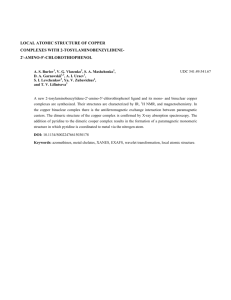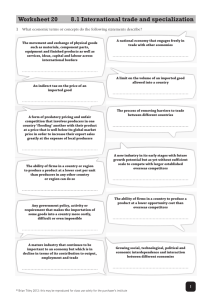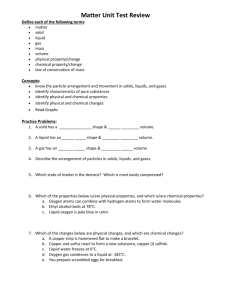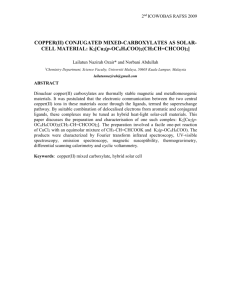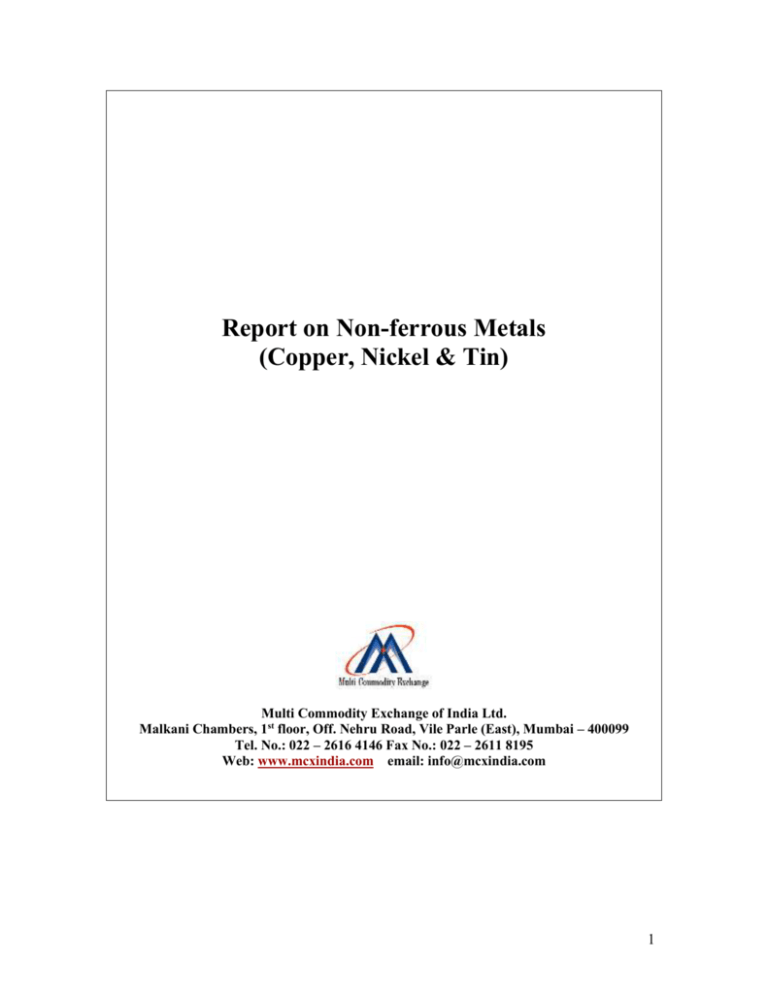
Report on Non-ferrous Metals
(Copper, Nickel & Tin)
Multi Commodity Exchange of India Ltd.
Malkani Chambers, 1st floor, Off. Nehru Road, Vile Parle (East), Mumbai – 400099
Tel. No.: 022 – 2616 4146 Fax No.: 022 – 2611 8195
Web: www.mcxindia.com email: info@mcxindia.com
1
Introduction
The nonferrous metals industry is a key sector in the Indian economy as it meets the requirements
of a wide range of key industries including engineering, electrical and electronics, infrastructure,
automobile and automobile components, packaging etc.
World markets for primary ferrous and non-ferrous metals are very volatile, and the metal
recycling industry closely follows these movements, both in prices and the strength or weakness
of demand.
Copper – Overview
Copper, one of the oldest commodities known to man, is a product whose fortunes directly reflect
the state of the world's economy. It is the world's third most widely used metal, after iron and
aluminum, and is primarily used in highly cyclical industries such as construction and industrial
machinery manufacturing.
Supply
The size of Indian Copper Industry is around 4 lakh tons, which as percentage of world copper
market is 3 %. Thus, the domestic prices normally follow the trends in the London Metal
Exchange (LME), in varying degrees, subject to the domestic demand-supply mismatch.
Copper Availability (Tons)
Year
Production
1990-91
40578
1991-92
45495
1992-93
45275
1993-94
39002
1994-95
46134
1995-96
41153
1996-97
38481
1997-98
42938
1998-99
145301
1999-00
220000
(Source: goidirectory.nic.in)
Import
Refined Copper
94236
61173
71553
121830
120561
103543
176797
149506
69353
N.A.
Scrap Copper
46251
47389
38070
69111
61115
81951
97504
105864
102650
N.A.
Demand
Copper Consumption (Tons)
Year
1990-91
1991-92
1992-93
1993-94
1994-95
1995-96
1996-97
1997-98
Consumption
207170
187890
195710
208430
287330
321080
347960
378680
2
1998-99
408270
1999-00
422870
(Source: goidirectory.nic.in)
Industry Structure
The Indian Copper industry comprises the primary, secondary downstream segments. Primary
producers are those players who process the mined ore to obtain the primary metal. This metal is
commercially available in the form of rods, ingots, cathodes, wires etc., Secondary producers are
those players who manufacture value added products like foils, extrusions, dry batteries, castings
etc., either by procuring the metal from the primary producers or from scrap. The domestic
industry is characterized by the presence of only a few players in the primary segment.
The primary copper industry in India is divided between three main players:
Hindustan Copper Limited.
Sterlite Industries (India) Ltd.
Birla Copper Ltd.
Company-wise smelting capacities in 2000-2001 in tons/annum:
Name of Organizations
Hindustan Copper Ltd.
Sterlite Industries (India) Ltd.
Birla Copper
Total
(Source: goidirectory.nic.in)
Existing
47,500
100,000
100,000
247,500
Proposed
61,500
100,000
150,000
311,500
In India the three major primary copper producers, import copper concentrate and hedge their
price risk in the London Metal Exchange. They then supply the value added products of copper
(cathodes, wire bars and continuous cast rods) to the secondary producers in the domestic copper
industry at the average LME cost of month of supply.
The secondary producers while entering into forward contracts with the end users and traders for
value added products of copper, fix the price upfront and are thus exposed to price risk for sales
commitments (as the raw material prices are highly volatile). Similarly, the end users who buy
copper semi-finished products from the secondary producers also run the price risk for their
purchases. Also the secondary producers, downstream segments and traders when holding large
stocks of copper are subjected to market risk due to high volatility in copper prices in LME.
Uses
The Indian copper industry has been around from the pre-historic ages and copper has been used
extensively in the past for manufacturing decorative art wares, hardware and utensils. The
modern Indian copper industry was only started after independence and has grown significantly
in last few years. An essential service material, Copper has the distinction of being
environmentally friendly, fully recyclable and fully sustainable. Copper and its alloys are being
widely used in architecture, automotive, building wires, commercial tubes, electric energy
efficiency motors, tube, pipe & fittings, rods & bars and telecommunications.
Of all the materials used by man, copper has had the most profound effect on civilization. From
the dawn of civilization and into the third millenium, copper has played, and continues to play a
3
vital role in contributing to, sustaining and improving society. What makes copper and copperbased products so valuable to us, and why do societies depend on them? Copper's chemical,
physical and aesthetic properties make it a material of choice in a wide range of domestic,
industrial, and high technology applications. Copper is ductile, corrosion resistant, malleable, and
an excellent conductor of heat and electricity. Alloyed with other metals, such as zinc (to form
brass), aluminum or tin (to form bronzes), or nickel for example, it can acquire new
characteristics for use in highly specialized applications. In fact, society's infrastructure is based
upon, in part, on copper. For instance, copper is used for:
· conducting electricity and heat;
· communications;
· transporting water and gas;
· roofing, gutters and downspouts;
· protecting plants and crops, and as a feed supplement; and
· making statues and other forms of art.
Copper has been in use for 10,000 years, yet, it is still a high technology material, as evidenced
by the development of the copper chip by the semi-conductors industry.
Copper occurs naturally in the environment in a variety of forms. It can be found in sulfide
deposits (as chalcopyrite, bornite, chalcocite, covellite), in carbonate deposits (as azurite and
malachite), in silicate deposits (as chrysycolla and dioptase), and as pure "native" copper.
Copper is one of the most recycled of all metals. It is our ability to recycle metals over and over
again that makes them a material of choice. Recycled copper (also known as secondary copper)
cannot be distinguished from primary copper (copper originating from ores), once reprocessed.
Recycling copper extends the efficiency of use of the metal, results in energy savings, and
contributes to ensuring that we have a sustainable source of metal for future generations.
Copper also occurs naturally in humans, animals, and plants. Organic life forms have evolved in
an environment containing copper. As a nutrient and essential element, copper is vital to
maintaining health. Life sustaining functions depend on copper.
Nickel - Overview
Nickel world market is characterized by strong demand, low stocks, constrained supply and
speculative activity. Rapid industrialization in China is driving world nickel demand growth.
Stainless steel capacity addition is also supporting the market.
Supply & Demand
(1000’ tons)
Supply
Western World
Eastern World Exports
Total Supply
Demand
Stainless Steel & Others
Market Balance
1999
2000
2001
2002
727
242
959
790
240
1030
845
245
1090
895
245
1140
1001
-32
1050
-20
1100
-10
1130
10
4
Industry Structures
Ore Mining – Smelting – Refining – First Use – End Uses
Majority of the plants are having integrated mines/ smelter & refinery operations
In First Uses – 65 % is for stainless steel and 35 % is for others
End Uses
24 % transport equipments
17 % electrical machinery & equipment
25 % engineering & non-electrical machinery
18 % metal goods
8 % building & construction
6 % other uses
World production in 2001 was 1,138,600 tons, major producers are Canada, Finland, Australia,
Russia and Dominican Republic.
World primary nickel consumption is about 1 million tons. Consumption centers are Japan 2 lakh
tons and European Union 3.74 lakh tons
India imports all its nickel requirements of nearly 25,000 tons each year. The metal is mainly
used for making stainless steel and coins, electroplating and providing a protective coating for
other metals.
In the mid 18th century, primary nickel was first isolated as a separate metal. Prior to this, it was
found in copper mines and thought to be an unsmeltable copper ore. Primary nickel can resist
corrosion and maintains its physical and mechanical properties even when placed under extreme
temperatures. When these properties were recognised, the development of primary nickel began.
It was found that by combining primary nickel with steel, even in small quantities, the durability
and strength of the steel increased significantly as did its resistance to corrosion. This partnership
has remained and the production of stainless steel is now the single largest consumer of primary
nickel today. This highly useful metal is also used in the production of many different metal
alloys for specialised use.
Nickel industry is characterized by
Undisciplined production
Poor historical returns
Flattening cost curves
Governmental legislation
Tin
The annual Indian market for tin slab is around 18,000 tons. Tin is used in various end-use
markets and is produced in 40 countries.
World production in 2001 was 261,000 tons per annum.
5
Tin, like copper, was one of the first metals mined and its excellent qualities and shiny finish
made it a highly sought after commodity. Particularly liked for its fusion abilities in the making
of alloys, notably bronze, and its non-toxic qualities, tin was soon traded in many parts of the
world. Not surprisingly, it was traded on the LME from the market’s outset in 1877. Today it is
still used in the production of bronze, pewter and die-casting alloys and, in modern engineering,
to make tungsten more machineable. However, the largest uses for tin are for the production of
solders and for tin plating (providing an attractive coating to iron and steel products).
The Economics of Tin
Consumption of tin in market economies is forecast to rise by 2.5% per year to 1998. Most of this
growth will come from the Asian NICs and the region as a whole will account for 32% of world
MEC demand by the same year. After a decade of recession in the tin sector, the outlook for tin
appears brighter. The average annual tin price is forecast to rise by around 20% in 1995,
influenced by an upturn in market economy demand and lower levels of Chinese exports. Market
economy consumption, which dropped by 8% between 1990 and 1993 to 224,800t, is forecast to
rise by nearly 2.5% py through 1998. This growth in tin consumption will be centered in the
industrialising countries of Asia, and Asia as a whole is forecast to account for 20% of MEC
demand by 1998, a rise from 9% in 1985. The future balance between supply and demand in the
tin market depends on the level of Chinese exports: these are unlikely to regain 1993/94 levels
due to tighter export restrictions, a reduction in domestic inventories and an increase in domestic
demand.
Indium Corporation of America has produced a tin-indium-silver solder, which is claimed to be
the first direct replacement for 63% tin-37% lead solder. At current levels of solder production,
substitution of traditional alloys by alloys containing 90% tin could increase tin consumption in
the electronics industry alone by 15,000-20,000tpy.
Market economy refined tin production is forecast to increase by 12,000t between 1995 and 1997.
China, Malaysia, Indonesia, Bolivia and Brazil together accounted for 87% of world production
in 1993. By contrast, there has been no output in North America since 1989 and western Europe
accounts for just 1% of world production.
ITRI Ltd (formerly the International Tin Research Institute) is actively promoting use of tin in
tin-zinc and tin-nickel coatings, in lead-free gunshot, tin alloy bottle capsules and flame
retardants. A growth in tin consumption of 20,000-30,000t is possible over the next two to three
years if tin penetrates these new markets.
Why Futures in Non-ferrous Metals (Copper, Nickel and Tin)
Price Volatility
The below tables show the high variation in copper, Nickel and Tin prices in the LME
Frequency Distribution of Daily Price Variation in LME between Jan 99 – Dec 2003
Daily Percentage Variation
Copper
Cash (No. of Times)
Cash (% Times)
3 Month Contract (No of Times)
<2
2–5
>5
1158
92.1
1175
98
7.8
81
2
0.2
2
5–8
>8
6
3 Month Contract (% Times)
Nickel
Cash (No. of Times)
Cash (% Times)
3 Month Contract (No of Times)
3 Month Contract (% Times)
Tin
Cash (No. of Times)
Cash (% Times)
3 Month Contract (No of Times)
3 Month Contract (% Times)
93.4
6.4
925
73.5
957
76.1
301
23.9
275
21.9
1183
94
1185
94.2
69
5.5
68
5.4
0.2
26
2.1
21
1.7
6
0.5
5
0.4
6
0.5
5
0.4
Annexure
Characteristics of Copper
Copper, one of the oldest commodities known to man, is a product whose fortunes directly reflect
the state of the world's economy. It is the world's third most widely used metal, after iron and
aluminum, and is primarily used in highly cyclical industries such as construction and industrial
machinery manufacturing.
Profitable extraction of the metal depends on cost-efficient high-volume mining techniques, and
supply is sensitive to the political situation, particularly in those countries where copper mining is
a government-controlled enterprise.
Copper was first worked about 7,000 years ago. It's softness, color, and presence in nature
enabled it to be easily mined and fashioned into primitive utensils, tools, and weapons. Five
thousand years ago, man learned to alloy copper with tin, producing bronze and giving rise to a
new age. Thus copper was established as a commodity with commercial value.
In the early 20th century, new mining and smelting techniques were developed in the United
States which made it possible to process lower-grade ores, resulting in a dramatic global
expansion of the copper market.
World Markets/Exchanges
Copper producers (i.e., mining companies) sell their production to customers, who transform the
copper into various shapes and alloys. The copper is then sold to downstream fabricators, who
manufacture a variety of end-use products. The copper producers and their customers come
together at commodity exchanges, which provide all of the mechanisms and facilities needed to
trade copper.
Copper is traded on three commodity exchanges: On the LME, copper is traded in 25-ton lots and
quoted in US dollars per ton. On COMEX, copper is traded in lots of 25,000 pounds and quoted
in US cents per pound. On the SHME, copper is traded in lots of 5 tons and is quoted in
Renminbi per ton.
LME Copper Grade A Futures Contract Specification
Contract
Grade A Copper
Lot size
Lot size 25 tons (with a tolerance of +/- 2%)
Form
Grade A cathodes conforming to BS 6017-1981 (1989)
7
Delivery dates
Daily for cash to 3 months (first prompt date two working days from cash).
Then every Wednesday from 3 months to 6 months. Then every third
Wednesday from 7 months out to 63 months
US dollars per ton
Price 50 US cents per ton
Quotation
Minimum
Movement
Clearable currencies
US dollar; Japanese yen; sterling; euro
The industry usage is of Copper Grade A, which has a world production of 15,544,500 tons per
annum (2001)
Table 1: Volume of Copper Futures Trading in International Exchanges
Exchange
Future
Contract Unit
2000
1999
LME
Copper Grade A
25 tons
16,789,674
COMEX
High Grade Copper
25000 lbs
2,778,124 2,852,962
SME
Copper
5 tons
2,674,016 2,559,687
1998
15,699,702
2,483,610
2,772,124
1997
15,099,842
2,356,170
1,299,520
Figure 1: Trend in LME Copper Cash prices
Forms of Copper:
Copper is shipped to fabricators mainly as cathode, wire rod, billet, cake (slab), or ingot. Through
extrusion, drawing, rolling, forging, melting, electrolysis, or atomization, fabricators can form
wire, rod, tube, sheet, plate, strip, castings, powder, and other shapes. These copper and copperalloys are then shipped to manufacturing plants that make products to meet society's needs.
World Copper Consumption
Since the beginning of the century, industrial demand for refined copper has increased from 494
thousand to over 13,000 thousand metric tonnes.
Prior to the Second World War, demand grew at an annual rate of 3.1%. During the post war
expansion years (1945 to 1973) demand grew by 4.5% per year. Since the first oil shock of 1974,
8
demand has grown by 2.4% per year. During the 1990's, demand for copper has resumed at an
above average rate of 2.9%.
Changes in Copper Consumption
From 1960 to 1997 world copper consumption leapt from 3735 kt to 13084 kt.
The industrialization of developing economies in Asia, and the drive to improve standards of
living in the region, fuelled the demand for copper over the last 10 years.
9
Consumption per Capita
As world population continues to expand, demand for copper tends to increase as well, while
remaining sensitive to variances in economic cycles, changes in technology, and competition
between materials for use in applications.
Intensity of Use (1996)
The intensity of use for a material relates the demand (consumption) of that material to economic
activity (gross domestic product, or GDP).
More developed regions of the world benefit from a well established infrastructure, to which
copper is an important contributor.
As less developed regions expand their infrastructure, copper and other materials will form the
building blocks needed to increase living standards.
10
Source: Consumption (of refined copper): ICSG; Gross Domestic Product: World Bank;
Population: United Nations. Using consumption of refined copper as a measure of demand for a
region may result in understating true consumption for importing regions, and overstating
consumption for exporting regions.
Trade, Exports and Imports
Major Trade Flows of Copper Ores and Concentrates
11
Leading Exporters and Importers of Copper Ores and Concentrates, 1997 (copper content)
Major Trade Flows of Refined Copper
12
Leading Exporters and Importers of Refined Copper, 1997
13
Nickel LME Contract
Size of Lot
6 tonnes
Major Currency
The LME uses US Dollars as its major currency for each contract, the currency in which dealings
on the floor are transacted and which is used for the announcement of the official prices.
However, Sterling, Euro and Japanese Yen also constitute good currencies for clearing purposes
for all LME metals. Therefore the LME announces the exchange rates each day that the clearing
house will use for evaluating the settlement prices.
Minimum Price Movement
$5 per tonne
Delivery Dates
Daily for 3 months forward, then every Wednesday for the next 3 months and then every third
Wednesday of the month for the next 21 months. (A total of 27 months forward).
Quality
The primary nickel delivered under this contract must be primary nickel of minimum 99.80%
purity with chemical analysis conforming to the current ASTM specification.
Shapes & Weights
All primary nickel delivered must be:
14
a) of the production of those producers named in the LME-approved list
b) in the form of either cathodes or pellets or briquettes.
In the case of cathodes deliveries shall be made in the form of
a) sizes cut to either 100mm x 100mm (4" x 4"), 50mm x 50mm (2" x 2"), or 25mm x 25mm (1"
x 1"), size tolerances in accordance with internationally accepted trade practice.
b) sizes of full plate, excluding loops, up to 1000mm x 1300mm maximum with a thickness range
of 2mm to 15mm.
Each warrant of drummed or nickel cathodes shall consist of only one size.
All cut nickel cathodes, pellets or briquettes delivered shall be packed in sound steel drums with a
net weight of minimum 150 kgs and maximum 500 kgs. On or after 16th April 1995, all such
nickel delivered for warranting shall be packed in sound steel drums with an even net weight (+/2% more or less) of minimum 150 kgs and maximum 500 kgs. Each warrant shall consist of
drums of uniform size and weight. The gross and net weights must be clearly marked/strapped on
each individual drum together with the brand name.
Each warrant of full plate cathodes either comprising trimmed or untrimmed cathodes shall lie at
one warehouse and be of one brand, shape and size. Each bundle of full plate cathodes placed on
warrant shall be securely strapped in two dimensions with corrosion resistant material to permit
safe handling and transport without bundle distortion and breakage on steel or wooden skids
(pallets not permitted) with ground clearance of 75mm minimum. Bundles should not exceed 1.6
tonnes in weight and with the brand name marked indelibly either a) on clips attached to the
producer's bundle strapping, or b) on producer's strapping, or c) on each cathode within each
bundle or d) on an indestructible tag attached to each bundle. The lot number, gross and net
weights should also be either marked indelibly on a) the top cathode within each bundle or b) an
indestructible tag attached to each bundle.
Tin LME Contracts
Size of Lot
5 tonnes
Major Currency
The LME uses US Dollars as its major currency for each contract, the currency in which dealings
on the floor are transacted and which is used for the announcement of the official prices.
However, Sterling, Euro and Japanese Yen also constitute good currencies for clearing purposes
for all LME metals. Therefore the LME announces the exchange rates each day that the clearing
house will use for evaluating the settlement prices.
Minimum Price Movement
$5 per tonne
15
Delivery Dates
Daily for 3 months forward, then every Wednesday for the next 3 months and then every third
Wednesday of the month for the next 9 months. (A total of 15 months forward).
Quality
The tin delivered under this contract must be refined tin of minimum 99.85% purity and
conforming to BS3252:1986. Warrants issued after 16th September 1996 must conform to the
chemical composition of BS EN 610:1996. All tin delivered must, therefore, be:
a) of brands listed in the LME-approved list of tin brands
b) either in ingots or slabs each weighing not less than 12 kgs or more than about 50 kgs.
Shapes & Weights
Each parcel of 5 tonnes shall lie at one warehouse and be of one brand, shape and size, subject to
the necessity of including different shapes and sizes at the bottom of each parcel for the purpose
of palletisation. Each parcel placed on warrant shall be delivered securely strapped, in bundles not
exceeding 1.2 tonnes. Additionally, on and after 18th December 1995, each parcel placed on
warrant shall be securely strapped in bundles to permit safe handling without bundle distortion
and breakage.
Disclaimer
This document is for information purpose only. Certain information herein has been acquired
from various external sources believed to be reliable. While we have taken reasonable care during
compilation of this document, we assume no responsibility for any error or discrepancy in the
information herein. You must make appropriate judgement without any prejudice or compulsion.
Copyright
All rights reserved. No part of the newsletter can be reproduced or copied in any form by any
means without the prior permission of Multi Commodity Exchange of India Ltd.
Contact Us
Multi Commodity Exchange of India Ltd.
1st Floor, Malkani Chambers, Off Nehru Road,
Vile Parle (East)
Mumbai – 400099
Tel: 91-22-26164146
Fax: 91-22-26118195
Email: info@mcxindia.com
Website: www.mcxindia.com
16




